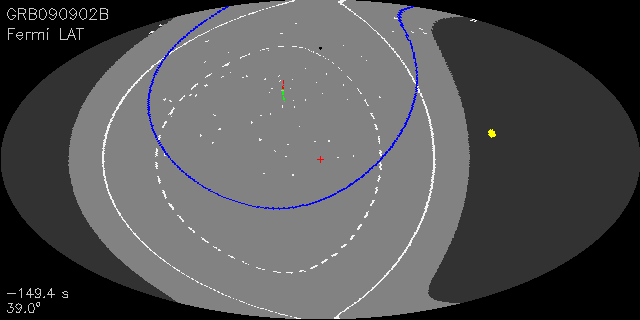
Handy Links
SLAC News Center
SLAC Today
- Subscribe
- Archives: Feb 2006-May 20, 2011
- Archives: May 23, 2011 and later
- Submit Feedback or Story Ideas
- About SLAC Today
SLAC News
Lab News
- Interactions
- Lightsources.org
- ILC NewsLine
- Int'l Science Grid This Week
- Fermilab Today
- Berkeley Lab News
- @brookhaven TODAY
- DOE Pulse
- CERN Courier
- DESY inForm
- US / LHC
SLAC Links
- Emergency
- Safety
- Policy Repository
- Site Entry Form

- Site Maps
- M & O Review
- Computing Status & Calendar
- SLAC Colloquium
- SLACspeak
- SLACspace
- SLAC Logo
- Café Menu
- Flea Market
- Web E-mail
- Marguerite Shuttle
- Discount Commuter Passes
-
Award Reporting Form
- SPIRES
- SciDoc
- Activity Groups
- Library
Stanford
Around the Bay
Fermi Telescope in Action: Capturing a Gamma-ray Burst
The gamma-ray burst detected by the Fermi Gamma-ray Space Telescope on September 2 was a big one, and included the highest-energy gamma-ray so far measured from such a burst. When the telescope's Gamma-ray Burst Monitor caught the bright flash of gamma rays, the Fermi spacecraft rotated so that its main instrument, the Large Area Telescope, could get a closer look. The animation below shows the LAT's field of view (blue circle) swing over to center on the burst, visible as a bright flash of white near the beginning of the animation.
Each frame in the animation shows an all-sky map centered on the burst, which is indicated by the red cross. The LAT's field of view covers about 20 percent of the entire sky at any given instant. The red and green line segments indicate the viewing direction and roll angle of the LAT. The dark shaded area shows the part of the sky that is blocked by the earth. The yellow circle represents the sun.
Each time step in the animation is 15 seconds. The sequence starts about 2 minutes before the burst. The time in the lower left indicates the number of seconds before or since the event. The white dots in each frame show the locations of the individual gamma rays detected during the previous 15-second interval.
As the animation begins, the LAT is in survey mode and scanning the sky. When the burst happens (bright white flash), the Gamma-ray Burst Monitor asks the spacecraft to switch to a pointed observing mode, so it can dwell on the location of the burst to look for delayed or "afterglow" gamma-ray emissions. In this mode, the LAT aims toward the burst until the center of its field of view is within 20 degrees of the horizon (indicated by the solid white line). The special pointed observations of the burst paid off; the data indicate a high-energy afterglow of several minutes duration following the initial flash.
By that time the LAT's view intersects the horizon (dark gray area). In the directions at or below the horizon, the gamma-ray intensity is very high owing to interactions of cosmic rays with the Earth's upper atmosphere (profusion of white dots). Because this bright gamma signal obscures the direction of the burst, the spacecraft starts to steer the LAT across the sky to meet the direction of the burst when it rises again on the other side of the earth.
The animation ends and loops back to the beginning about 2000 seconds after the burst.

—Seth Digel
SLAC Today, September 23, 2009